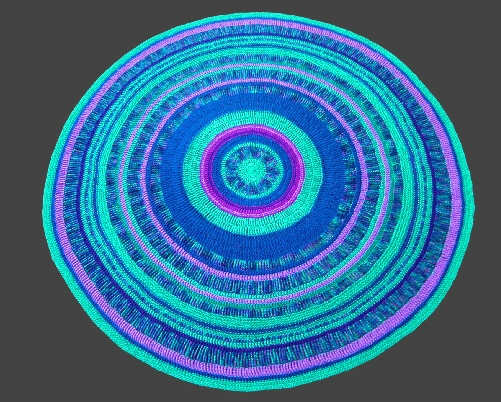




People often ask if knitting and crochet can be combined. Of course they can! I have
often done it before with small things but now I set out to create a circular afghan
using both crafts -
The calculations needed in any piece of knitting or crochet rely on both the proportions, and the size. of the stitches used. This is usually referred to as gauge, or tension. Increasing for a circle is an added complication and a lot of people have great difficulty trying to get their heads round how a circle gets bigger. Too many increases make a circle ruffle because the extra fabric won’t lie flat; too few increases and the circle starts to form a bowl.
Assuming that all the rings of a circle are the same height, you only need to make the same number of increases in the ring, regardless of whether it is a tiny ring in the centre, or a large one at the outer edge. This is a real stumbling block for some people as it seems more logical to think that a big ring needs more increases.
This has echoes of the mathematical Rope around the earth problem where an amazingly
small amount of extra rope would be needed to circle the earth one foot above the
surface of the equator compared with a snug-
Once the concept of increasing is understood it gets easier to compare and combine
stitches. As a general rule, when working in treble crochet it takes 12 extra trebles
on each round to make the circle lie flat. Double crochet is only about half the
height of treble so only needs 6 increases to stay flat. Similar calculations can
be made for stitches of any height. When you are working in trebles, you produce
relatively narrow rings as the stitches don’t need to spread very far. If you decide
to use quintuple-
Note: All of our crochet patterns use UK terminology for stitches, which is different from the system used in US. What we call a double, they call a single; our treble is their double; all descriptions differ by one.
Conveniently, garter stitch knitting forms a circle if 6 stitches are added on each garter ridge. This means knit and crochet stitches can be easily matched. The increases (both knit and crochet) don’t have to be limited to the specified numbers. If the calculations say that 6 increases are needed on each round, you could change that to 12 increases on every second round, 18 stitches on every third round, etc.
To add even more variety, with equally easy calculations, some of the garter stitch rings are worked perpendicular to the previous ring.
Combining techniques and stitches can lead to some very interesting combinations.
The pattern is a recipe for combining your own results based on specific details about the relative heights of the stitches.
